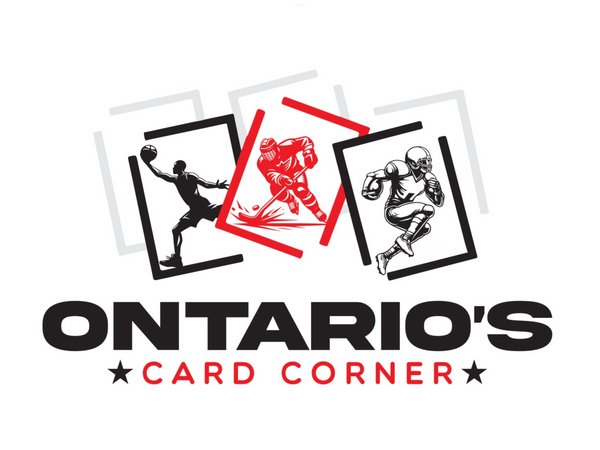How to Predict Which Rookie Cards Will Increase in Value
Share
Hello, collectors! Coleman Bennett here, owner of Ontario’s Card Corner. One of the most exciting aspects of the hobby is the hunt for rookie cards. These cards often represent the first chapter in a player’s career and can become the cornerstone of a valuable collection. But not all rookie cards are created equal, and predicting which ones will increase in value takes some research, knowledge, and a bit of intuition.
In this blog, I’ll share insights on how to evaluate rookies and their potential, so you can make smarter investments and build a collection that stands the test of time.
1. Performance Matters: The Stats Speak
A. Immediate Impact
-
Players who make a strong impression early in their careers often see a rapid increase in card value. Look at their stats, media coverage, and overall impact on their team.
-
Examples:
-
Connor McDavid’s incredible debut season boosted the demand for his Young Guns rookie card.
-
Patrick Mahomes’ record-setting performances quickly elevated his Panini Prizm rookie cards.
-
B. Consistency Over Time
-
Flashy debuts are great, but sustained excellence is what drives long-term value. Watch how rookies perform over multiple seasons to gauge their staying power.
-
Tip: Track rookies with strong fundamentals who are poised for consistent contributions to their teams.
2. The Role of Draft Position and Hype
A. High Draft Picks
-
Players drafted in the first round often carry significant hype, and their cards are initially in high demand. However, not all high picks pan out, so do your homework.
-
Examples:
-
Trevor Lawrence (NFL) and Cale Makar (NHL) were high draft picks whose performances justified the initial buzz.
-
B. Underdogs and Late Bloomers
-
Keep an eye on players drafted in later rounds or those with less initial hype. When these players break out, their cards can experience dramatic increases in value.
-
Examples:
-
Tom Brady’s sixth-round draft status didn’t stop his rookie cards from becoming some of the most valuable in the market.
-
3. Team Context and Market Size
A. Team Success
-
Rookies playing for successful or high-profile teams often gain more attention, driving demand for their cards.
-
Examples:
-
Jayson Tatum’s rookie cards gained traction as the Boston Celtics emerged as title contenders.
-
B. Market Size
-
Players in larger markets (e.g., New York, Los Angeles, Toronto) benefit from increased media exposure, which can boost card value.
-
Tip: Don’t overlook players in smaller markets who dominate their sport; their cards may still hold great potential.
4. Card-Specific Factors
A. Popular Rookie Card Brands
-
Certain brands and sets are more desirable among collectors, such as:
-
Hockey: Upper Deck Young Guns, SP Authentic Future Watch.
-
Football: Panini Prizm, Optic Rated Rookies.
-
Basketball: Panini Prizm, National Treasures RPAs.
-
Baseball: Topps Chrome, Bowman First Chrome.
-
B. Parallels and Variants
-
Rare parallels, low-serial-number cards, and autographs are in higher demand. Look for cards like:
-
Young Guns High Gloss (/10) or Exclusives (/100).
-
Panini Prizm Silver and Gold parallels.
-
Bowman Chrome autographed rookies.
-
C. Graded Cards
-
Professionally graded rookie cards (PSA, BGS, SGC) command higher prices, particularly in mint or gem mint conditions.
-
Tip: A PSA 10 can often double or triple the value of a raw card.
5. Research and Tools for Evaluating Rookies
A. Stay Informed
-
Follow the latest news, highlights, and expert analysis to identify breakout players.
-
Resources:
-
Sports news outlets like ESPN, TSN, and The Athletic.
-
Hobby-focused platforms like Beckett, Market Movers, and Card Ladder.
-
B. Use Data
-
Analyze stats such as scoring, assists, and advanced metrics to identify players outperforming expectations.
-
Example Tools:
-
Pro Football Focus (NFL stats and analysis).
-
Hockey Reference (NHL stats and projections).
-
C. Engage with the Community
-
Join collector groups, forums, and social media communities to share insights and learn about rising stars.
6. The Importance of Patience
Not every rookie’s value will skyrocket overnight. Investing in rookie cards often requires patience as players develop their skills and establish themselves.
A. Long-Term Investments
-
Look for players with strong work ethics, leadership qualities, and potential for Hall of Fame careers.
B. Avoid Over-Hyped Fads
-
Be cautious of players whose value is driven primarily by short-term media hype rather than consistent performance.
7. Examples of Rookie Cards That Increased in Value
A. Connor McDavid (Hockey)
-
Card: 2015 Upper Deck Young Guns
-
Value Growth: Initially sold for $200-$300 raw, now valued at over $3,000 in PSA 10.
B. Luka Dončić (Basketball)
-
Card: 2018 Panini Prizm Silver
-
Value Growth: Raw cards started around $50, now exceeding $2,000 in PSA 10.
C. Patrick Mahomes (Football)
-
Card: 2017 Panini Prizm Silver
-
Value Growth: Initially sold for $100-$200, now worth over $10,000 in PSA 10.
Final Thoughts
Predicting which rookie cards will increase in value requires a mix of research, observation, and intuition. By focusing on player performance, team context, card-specific factors, and market trends, you can make smarter investments in the hobby. Remember, collecting rookie cards isn’t just about potential profit—it’s also about celebrating the excitement of a player’s journey.
At Ontario’s Card Corner, we’re here to help you navigate the world of rookie card investing. If you’re looking for advice or need help finding the next big thing, don’t hesitate to reach out.
Happy collecting!
Coleman Bennett
Owner, Ontario’s Card Corner
